Students will examine the artistic characteristics of the Mummy Case, explore the meaning of various symbols on the case, and write a short essay identifying modern-day equivalents of the ancient Egyptian symbols and their reasons for choosing them.
Students will be able to:
- examine the artistic characteristics of the Mummy Case;
- locate Egypt on a map of the world and identify some defining features of the country;
- describe various symbols on the ancient Egyptian Mummy Case and their significance; and
- write a short essay identifying modern-day equivalents for symbols on the mummy case, including why they chose these particular symbols as modern-day equivalents.
Lesson
- Display the Mummy Case and invite students to look carefully and share what they observe. What do they notice about the case? What colors do they see? What patterns are included? What intriguing details do the students notice? How does the Mummy Case compare with other art objects the students have seen? What adjectives would they use to describe the case?
- Share with students that the Mummy Case was created by an unknown artist in ancient Egypt around 332–302 B.C.
- Explain to the students that there are many symbols on the Mummy Case. Discuss the idea of symbols.
- Divide students into five groups. Have each group research a different symbol (one of the five listed below) and find the following information: What is it? What does it “do?” How was the symbol used in ancient Egypt? Where was it usually found? Where is this symbol on the Mummy Case?
- According to the information in the “What Inspired It?” section, the goddess Nut is a symbol of resurrection and immortality, the god Anubis represents protection, the god Horus is a symbol of divine kingship, the “was” scepter was a sign of authority and power, and lotus flowers represent creation and rebirth. Encourage students to locate these various symbols on the Mummy Case.
- Invite the students to work in pairs or in a small group and brainstorm modern-day equivalents of these symbols. Ask the students: What symbols today represent protection? What could represent authority in today’s world? Invite students to share their thoughts with the rest of the class. Record their ideas on a large piece of chart paper or (interactive) whiteboard. Did any groups come up with the same ideas?
- Lead a discussion about the variety of modern-day equivalents of the ancient symbols, recognizing that the students probably come from a number of different cultural backgrounds.
- Have the students choose one symbol from the Mummy Case and talk about what they view as the best modern-day equivalent for this symbol. Instruct the students to write a short essay about why their choice of contemporary equivalent is the best representation of the ancient Egyptian symbol.
- When students are finished, invite volunteers to share their ideas. Be sure to display the students’ written compositions in a prominent place in the classroom.
Materials
- Lined paper and pen/pencil for each student
- Large piece of chart paper or (interactive) whiteboard for recording students’ ideas
- Map of the world, visible to all students in the classroom
- About the Art section on Mummy Case
- One color copy of the Mummy Case for every four students, or the ability to project the image onto a wall or screen
- Computer with internet access and/or books with information on ancient Egyptian symbols
Standards
- Social Studies
- History
- Geography
- Understand the concept that the power of ideas is significant throughout history
- Become familiar with Eastern Hemisphere historical eras, groups, individuals and themes
- Analyze the concepts of continuity and change and effect
- Analyze the concept of complexity, unity and diversity
- Become familiar with United States historical eras, groups, individuals and themes
- Become familiar with World geography
- Use geographic tools and sources to answer spatial questions
- Visual Arts
- Observe and Learn to Comprehend
- Relate and Connect to Transfer
- Envision and Critique to Reflect
- Language Arts
- Oral Expression and Listening
- Research and Reasoning
- Writing and Composition
- Reading for All Purposes
- Collaboration
- Critical Thinking & Reasoning
- Information Literacy
- Invention
- Self-Direction
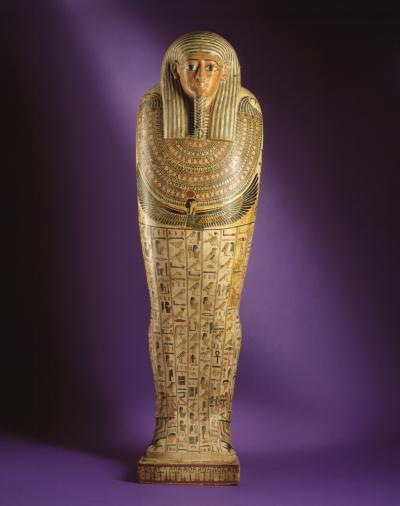
Mummy Case
Museum Purchase, Collector's Choice, 1965.14 Photograph © Denver Art Museum 2009. All Rights Reserved.
We don’t know who made this case, but we do know that it was made for a man who was thought to be living in Egypt during the 3rd century B.C. Mummification—preserving a person, and in some instances, animals, for the afterlife—was commonly practiced in ancient Egypt. After bodies were mummified, they were placed inside special cases like this one that served to protect the body. This case was carved out of rare cedar wood, which suggests that it was made for a person of high status in Egyptian society. Once the construction of the case was complete, artists painted symbols and hieroglyphs, or “sacred texts,” onto its surface. In the Ptolemaic [TALL-uh-may-ick] period (332–303 B.C.), when this case was made, there was an increase in realism in Egyptian art. There is distinct modeling in the face on the surface of this case, but we don’t know whether those who made the image intended for it to represent a portrait of the deceased, or a more generalized visage.
Mummy cases offered physical protection from animals and other intruders, as well as a more spiritual form of protection. Hieroglyphs were painted on both the inside and outside of the case, providing prayers for protection and praise for the individual in the afterlife. Curiously, the Egyptians had standard prayers that they would use, and the text here was not unique to the individual for whom this case was made.
Many ancient Egyptian symbols of death and rebirth are painted on this mummy case. Below the falcon collar is Nut [noot], the sky goddess and mother of Osiris [oh-SIGH-russ], god of the underworld and symbol of resurrection and immortality. It was believed that Nut swallowed the sun each evening and gave birth to the sun each morning. Because of her connection to the solar cycle, she became a symbol of resurrection and rebirth. On either side of the base of the coffin are images of Anubis [uh-NOO-biss], the god of mummification. Anubis is usually represented with the head of a jackal and the body of a man, but is shown here as a full jackal. Anubis is the guardian of the cemetery; he attends to and protects the mummy in his or her tomb. Anubis would also oversee the ritual of embalming (preparing the body to be wrapped).
Details
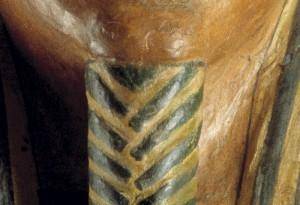
False Beard
In ancient Egypt, the beard was seen as an attribute of several of the gods. Although real facial hair was not often admired, Pharaohs (divine rulers) would wear false beards to signify their status as a living god. The false beard on the DAM’s mummy case does not signify that this is the mummy case of a pharaoh, but that the deceased wanted to be associated with Osiris, who also wore a false beard in his role as ruler of underworld. False beards were often braided, signified here by the lines slanting inward in the same gold and green colors as the wig.
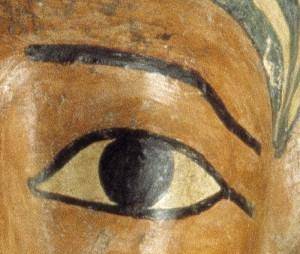
Outlined Eyes
Although physical appearance was of great importance to the Egyptians, this was not the sole reason for the use of makeup. Eye makeup was also used for spiritual, magical, and therapeutic purposes. The Egyptians used a mineral called kohl to outline their eyes. Some believe that with this makeup, Egyptians were attempting to associate themselves with the cat, a variety of which were honored in Ancient Egypt. Cats represented beauty and prosperity, among other things. It is also said that the kohl would protect the eye against common infections.
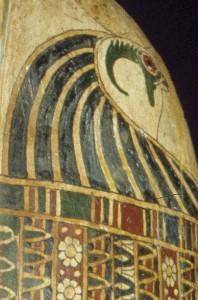
Collar
Covering the mummy’s chest is a collar consisting of 16 rows of flowers, petals, and leaves with three different patterns. One row is composed of upside-down lotus flowers and buds. The next row is made up of another flower that seems similar to a daisy. It is hard to tell whether the third pattern represents a type of flower or leaf, or just a design. At each end of the collar is the head of a falcon, which was a symbol of Horus, the god of the sky and a symbol of divine kingship. He is also the god of order and justice, and he protects the deceased in this mummy case.
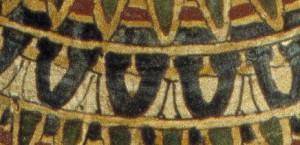
The Lotus
Lotus flowers grew along the Nile and were symbols of life and regeneration. At night, they close their blossoms and submerge themselves under water. In the morning, they emerge and open once again. Because of this pattern, lotus flowers became a symbol of the sun, with its daily cycles, and of creation and rebirth.

Hieroglyphic Inscriptions
The lower portion of the mummy case is covered with a hieroglyphic inscription. (The word hieroglyph means “sacred text.”) Most funerary inscriptions include spells and prayers that come from the Book of the Dead. The text often asks the gods for protection of the deceased on his journey to the afterlife. On the front of this coffin, the text is written primarily as though the owner of the coffin is speaking. At one point, he says to the gods, “May you rescue me from the aggressors who are in this land of the righteous! May you give me my mouth so that I might speak with it! May you give me my inheritance in your presence…”
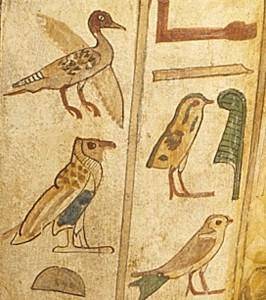
Birds
There are a number of birds on the DAM’s case, most of which are found in the form of hieroglyphs. There appear to be, among others, a sparrow, an ibis, a desert owl, and a duck.
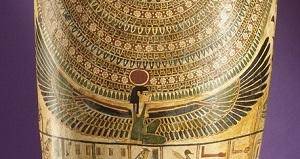
Nut’s Wings
Below the falcon collar, Nut’s wings are symmetrical, meaning that if you were to draw a vertical line down the center of her body, her wings would be the same on either side. Her wings resemble the cloisonné technique, an enameling process in which shapes are created with a thin metal wire and then filled with colored enamel powder. When heated to a certain temperature, the enamel powder melts, forming a solid area of color. The wire used is often gold, which is the color that outlines the individual feathers of Nut’s wings. Her green clothing is also outlined in gold to separate it from the feathers that surround it.
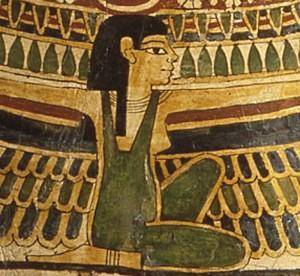
Mixed Perspectives
People and animals were commonly depicted partly in profile and partly from other views. Notice how the lower half of Nut’s body is in profile, while her arms are spread so that her collarbone and wings are facing the viewer. Also, though her face is seen from the side, we see her eye as though we are looking at it from the front.

The Ankh
The hieroglyph ankh, meaning “to live”, was the sign of eternal life in Ancient Egypt. It was a very powerful symbol and can be seen among the other hieroglyphs on the case.
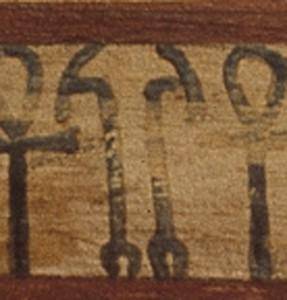
“Was” Scepter
The was scepter was a sign of authority and power and is meant to signify the well-being of the mummy. On the DAM’s case, two was scepters are placed back to back, alternating with the ankh symbol.
Funding for object education resources provided by a grant from the Morgridge Family Foundation. Additional funding provided by the William Randolph Hearst Endowment for Education Programs, and Xcel Energy Foundation. We thank our colleagues at the University of Denver Morgridge College of Education.
The images on this page are intended for classroom use only and may not be reproduced for other reasons without the permission of the Denver Art Museum. This object may not currently be on display at the museum.





